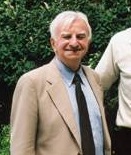Year: 2000
Ligon found that if the armature is a metallic permanent magnet rod, this rod will roll either in the forward or the retrograde direction, depending on the magnetic rod polarity in relation to the direction of current flow through the rod. This seems to prove that the magnetic interaction between rails and armature is superimposed on the electrodynamic Ampere interactions. The missing force law must agree with this finding.
Mueller suspended the whole railgun circuit on strings to form, what we have called, an impulse pendulum [7]. He then found that when the steel rod rolled in the retrograde direction. the rail "recoil" was also reversed and became a forward motion. This proves that the magnetic interaction forces between the rails and the unmagnetized steel armature are definitely mutual attractions overpowering the Ampere electrodynamic repulsions.
Some investigators have argued that the retrograde armature motion may be a result of the mechanics of rolling. When the center of the horizontal armature acceleration force lies below the rod axis, they suspect, the rod may roll in the opposite direction to the force. Textbooks on the Newtonian mechanics [8] show this to be incorrect. In slip-free rolling, the instantaneous center of rotation is not the rod axis. but a line through the points of contact between rod and rails. Any horizontal force perpendicular to the rod axis will therefore transport the armature in the same direction as the applied force. regardless of whether this force is applied above or below the rod axis.
Nasilowski [2] points out that our understanding of magnetism advanced by three giant leaps during the second millennium. The last of the great discoveries was made by Oersted when he revealed the interaction of a compass needle with an electric current. The microscopic mechanism underlying this discovery has remained concealed in spite of the introduction of field theory, atomism, the electron theory, and quantum mechanics. We're dealing with a very hard problem.
Dring [3] is undoubtedly correct in stressing that more attention should be paid to spins and magnetic moments of fundamental particles. It is interesting that he thinks of spins as consisting of magnetic dipoles. The Ampere current element is such a dipole. Magnetic flux density and Maxwell's equations are unlikely to be of any help. Retrograde railgun motion is an instance in which B is not equal to (mu)H. Magnetic and electric dipoles not only produce mutual attractions and repulsions; they also give rise to mutual torques.
Hughes [4] appears to believe that metallic current-carrying circuits always tend to deform themselves so that the stored magnetic (potential) energy is minimized. This applies to retrograde rail gun motion but not to the forward motion of a non-magnetic armature. In the latter case the forward force and motion increases the loop self-inductance and with it the stored energy 1/2LF, where i is the instantaneous current.
Worst of all, retrograde rail gun motion literally flies in the face of quantum electrodynamics (QED). In our book [7] we devote a whole chapter to "The railgun: Testbed of the Newtonian electrodynamics". Field theory and QED require energy to fly from the battery, between the rails, to the armature and give up its momentum on impact with the armature. We have shown that if momentum is conserved. E=mc2 is violated by a huge factor. In QED this traveling energy consists of photons which collide with the electrons of the armature and thereby produce the Lorentz force. Since QED is supposed to account for everything except gravitation and nuclear physics, it should apply to retrograde rail gun motion. The photons must then, somehow, navigate around the armature and strike it in the back. How can intelligent physicists, engineers, and mathematicians be so misled by their teachers?
The full paper will outline how retrograde railgun motion contradicts the theories of Faraday, Maxwell, Poynting, Lorentz, Einstein, and Feynman.
- P. Graneau, "The missing magnetic force law", Galilean Electrodynamics, Vol. 9, p.35 (1998).
- J. Nasilowski, "Necessary but missing research on magnetism", Galilean Electrodynamics, Vol. 10, p.17 (1999).
- A. Dring, "Comments on Graneau's retrograde railgun", Galilean Electrodynamics, Vol. 10, p.18 (1999).
- W.L. Hughes, "About railgun motion", Galilean Electrodynamics, Vol. 10. p.18 (1999).
- T. Ligon (8504 Saddle Court. Manassas, V A 20110), private communication.
- F. Mueller (8025 SW 15th Street, Miami. FL 33144), private communication.
- P. Graneau, N. Graneau, Newtonian Electrodynamics, World Scientific. New Jersey (1996).
- C. Kittel, W.D. Knight, M.A. Ruderman, Mechanics, McGraw Hill, New York (1973).


